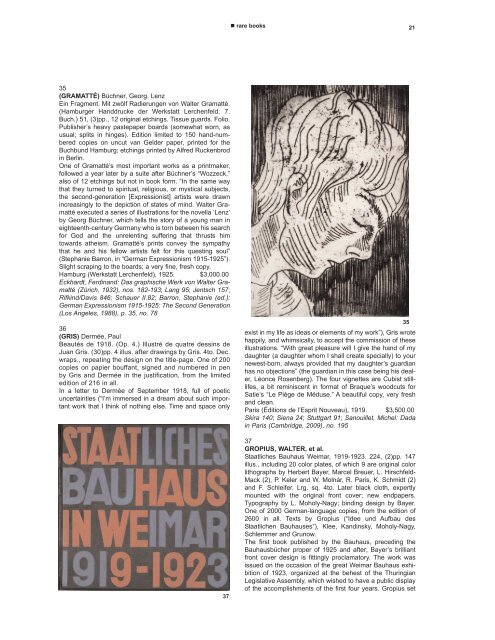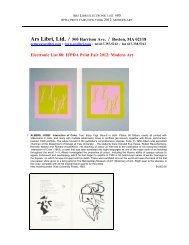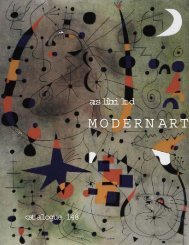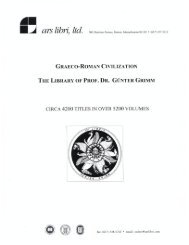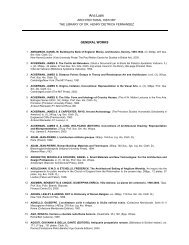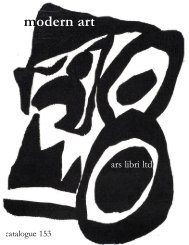Create successful ePaper yourself
Turn your PDF publications into a flip-book with our unique Google optimized e-Paper software.
35<br />
(GRAMATTÉ) Büchner, Georg. Lenz<br />
Ein Fragment. Mit zwölf Radierungen von Walter Gramatté.<br />
(Hamburger Handdrucke der Werkstatt Lerchenfeld. 7.<br />
Buch.) 51, (3)pp., 12 original etchings. Tissue guards. Folio.<br />
Publisher’s heavy pastepaper boards (somewhat worn, as<br />
usual; splits in hinges). Edition limited to 150 hand-numbered<br />
copies on uncut van Gelder paper, printed for the<br />
Buchbund Hamburg; etchings printed by Alfred Ruckenbrod<br />
in Berlin.<br />
One of Gramatté’s most important works as a printmaker,<br />
followed a year later by a suite after Büchner’s “Wozzeck,”<br />
also of 12 etchings but not in book form. “In the same way<br />
that they turned to spiritual, religious, or mystical subjects,<br />
the second-generation [Expressionist] artists were drawn<br />
increasingly to the depiction of states of mind. Walter Gramatté<br />
executed a series of illustrations for the novella ‘Lenz’<br />
by Georg Büchner, which tells the story of a young man in<br />
eighteenth-century Germany who is torn between his search<br />
for God and the unrelenting suffering that thrusts him<br />
towards atheism. Gramatté’s prints convey the sympathy<br />
that he and his fellow artists felt for this questing soul”<br />
(Stephanie Barron, in “German Expressionism 1915-1925”).<br />
Slight scraping to the boards; a very fine, fresh copy.<br />
Hamburg (Werkstatt Lerchenfeld), 1925. $3,000.00<br />
Eckhardt, Ferdinand: Das graphische Werk von Walter Gramatté<br />
(Zürich, 1932), nos. 182-193; Lang 95; Jentsch 157;<br />
Rifkind/Davis 846; Schauer II.82; Barron, Stephanie (ed.):<br />
German Expressionism 1915-1925: The Second Generation<br />
(Los Angeles, 1988), p. 35, no. 78<br />
36<br />
(GRIS) Dermée, Paul<br />
Beautés de 1918. (Op. 4.) Illustré de quatre dessins de<br />
Juan Gris. (30)pp. 4 illus. after drawings by Gris. 4to. Dec.<br />
wraps., repeating the design on the title-page. One of 200<br />
copies on papier bouffant, signed and numbered in pen<br />
by Gris and Dermée in the justification, from the limited<br />
edition of 216 in all.<br />
In a letter to Dermée of September 1918, full of poetic<br />
uncertainties (“I’m immersed in a dream about such important<br />
work that I think of nothing else. Time and space only<br />
37<br />
� rare books 21<br />
35<br />
exist in my life as ideas or elements of my work”), Gris wrote<br />
happily, and whimsically, to accept the commission of these<br />
illustrations. “With great pleasure will I give the hand of my<br />
daughter (a daughter whom I shall create specially) to your<br />
newest-born, always provided that my daughter’s guardian<br />
has no objections” (the guardian in this case being his dealer,<br />
Léonce Rosenberg). The four vignettes are Cubist stilllifes,<br />
a bit reminiscent in format of Braque’s woodcuts for<br />
Satie’s “Le Piège de Méduse.” A beautiful copy, very fresh<br />
and clean.<br />
Paris (Éditions de l’Esprit Nouveau), 1919. $3,500.00<br />
Skira 140; Siena 24; Stuttgart 91; Sanouillet, Michel: Dada<br />
in Paris (Cambridge, 2009), no. 195<br />
37<br />
GROPIUS, WALTER, et al.<br />
Staatliches Bauhaus Weimar, 1919-1923. 224, (2)pp. 147<br />
illus., including 20 color plates, of which 9 are original color<br />
lithographs by Herbert Bayer, Marcel Breuer, L. Hirschfeld-<br />
Mack (2), P. Keler and W. Molnár, R. Paris, K. Schmidt (2)<br />
and F. Schleifer. Lrg. sq. 4to. Later black cloth, expertly<br />
mounted with the original front cover; new endpapers.<br />
Typography by L. Moholy-Nagy; binding design by Bayer.<br />
One of 2000 German-language copies, from the edition of<br />
2600 in all. Texts by Gropius (“Idee und Aufbau des<br />
Staatlichen Bauhauses”), Klee, Kandinsky, Moholy-Nagy,<br />
Schlemmer and Grunow.<br />
The first book published by the Bauhaus, preceding the<br />
Bauhausbücher proper of 1925 and after; Bayer’s brilliant<br />
front cover design is fittingly proclamatory. The work was<br />
issued on the occasion of the great Weimar Bauhaus exhibition<br />
of 1923, organized at the behest of the Thuringian<br />
Legislative Assembly, which wished to have a public display<br />
of the accomplishments of the first four years. Gropius set


